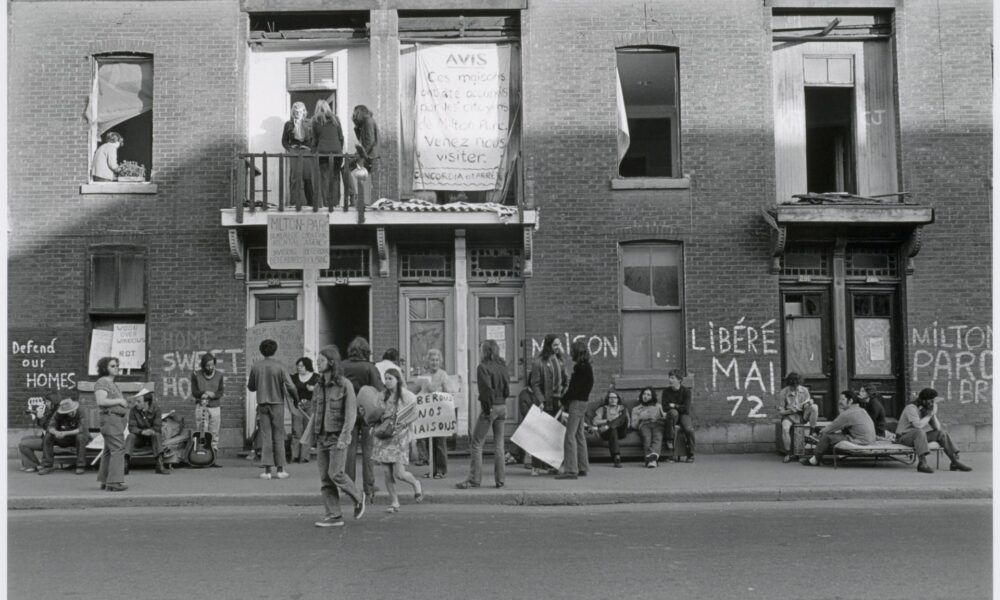The six blocks bounded by University, Ste. Famille, Milton, and des Pins form the notorious “McGill Ghetto”, a neighbourhood adjacent to campus, swarming with students and their vices. For first-years eager to integrate into McGill’s vibrant community, this area holds great appeal. It is a hub for young students to run free and make memories for the fleeting years that they are there—but at what cost? Not only does the name “McGill Ghetto” vainly claim this neighbourhood as students’ own, but it also offends the historic struggle to protect this cherished area against gentrification. Language matters. These six blocks are not the McGill Ghetto. They are Milton-Parc.
Nearly five decades ago, most of the historic buildings in Milton-Parc were purchased by the real estate giant Concordia Estates Ltd. in order to make room for shopping centres, hotels, and new high-rise, high-rent buildings. Local activists protested the construction, seeking to protect the community’s character and residents’ access to affordable housing. The protestors occupied the developers’ offices, and many were arrested and jailed for mischief. Remarkably, their movement to prevent the construction was successful. The familiar LaCité apartment building is the only project outlined in the $250-million development endeavour that was completed.
The struggle for Milton-Parc was a historic catalyst for similar municipal urban movements around the world and, to this day, it remains one of the largest housing projects in North America. Most buildings are owned by 22 non-profit and housing co-operatives, and community involvement is alive and well, represented by the Milton-Parc Citizens’ Committee (CCMP).
It is deeply disrespectful for students to ignore the plight of long-time residents considering the rich history of resistance and struggle to protect their neighbourhood. For decades, there has been tension between students ad established residents over the McGillians’ inclination for yelling in the streets at night, throwing loud parties, and recklessly throwing garbage onto the streets. Traditional gentrification harms communities through forced displacement and exclusion. Governments and corporations erase the history of entire neighbourhoods to make room for more profitable developments and demographics. But through so-called studentification, students harm communities through neglect, more so out of immaturity than profit-seeking.
Not to mention that the term “ghetto” is itself loaded, and its use in any case is inherently insensitive and should not be any student’s vocabulary. “Ghetto” originated in reference to the forced segregation of Jewish people into closed areas, and is now used as slang for neighbourhoods with high concentrations of ethnic minorities and levels of poverty. For students to distinguish it as such, based on their perception of the area as a playground for university life, further implies that the entire neighbourhood belongs to and revolves around us.
Paying attention to our language and using the correct terminology for Milton-Parc demonstrates an intention to improve relations with established residents and, ultimately, work together to benefit the entire community. For instance, Mobilizing for Milton-Parc (formerly Meals for Milton-Parc), a meal-share initiative providing food and care packages to unhoused people in the neighbourhood, was developed by former McGill student Sophie Hart (BA ‘22) in 2020. Participating in this initiative is one of many ways that students can shift to a more inclusive perspective of the neighbourhood—one that recognizes its existence outside the McGill bubble.
McGill students spend some of their most formative years in Milton-Parc, and, in turn, build valid emotional attachments to the area and incorporate it into their identity. If anything, it is because of these attachments that students should be more reflective and intentional about the language they use when referring to their neighbourhood. Milton-Parc is an anomaly in the capitalist landscape. It would not exist without residents’ persistent struggle, and they are owed the utmost gratitude and respect for their fight to protect our shared community.








